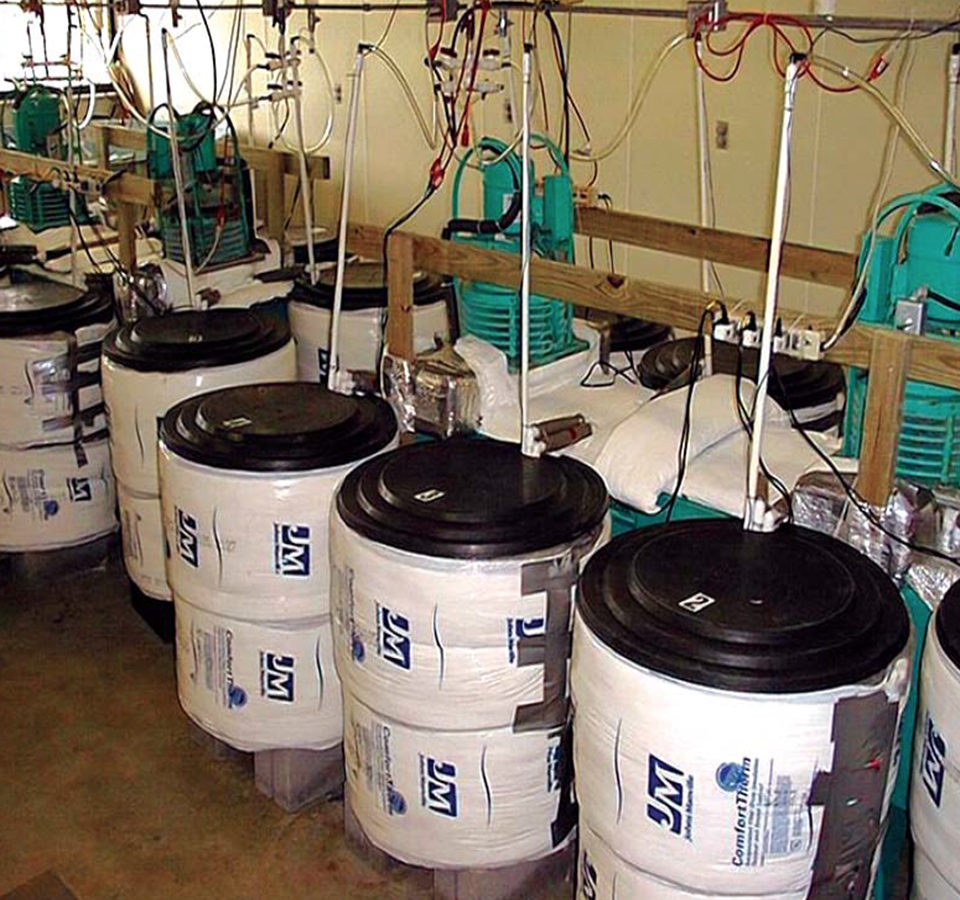System initially developed at Louisiana State University

Seasonal changes in natural aquatic systems determine variations in temperature that impact the system dynamics over time. The study of such systems in a laboratory setting requires the incorporation of computer control technologies that can simulate the temperature regimes of natural aquatic systems.
Technologies for closed recirculation systems have increasingly emerged to improve water quality while minimizing effluent discharges. Temperature control is also needed in such systems to help reduce water and labor costs.
Study setup
With support from the Louisiana Sea Grant College Program, the authors recently conducted a study to develop a design for a central chilling system that will be used for time- and temperature-controlled holding and water quality studies with Eastern oysters (Crassostrea virginica). The objectives were to provide sufficient, faster chilling at a lower and more consistent temperature than the previous system, with the ability to replicate tank conditions.
The system was initially developed at the Louisiana State University Aquaculture Research Station in Baton Rouge, Louisiana, USA, with four individual unit chillers in two central tanks. The recirculation system was used for holding and conditioning Eastern oysters for research on gametogenesis. A second system was designed and installed in the Department of Biological and Agricultural Engineering to enhance water quality studies on a small scale by simulating lightly loaded systems.
Designing a system with a central chiller enhanced chilling and research capacity because replicating experiments in a single process control system minimized variations in the temperatures and chilling rates in the individual tanks.
System testing
Test runs conducted on both chilling systems evaluated the temperature control, and the chilling capacity was determined based on chilling rates over time. The biofilters in the tanks at the research station were preacclimated at a salinity of 20 ppt to develop an active biofilm before use. The biofilters were active in seven days, with ammonia levels as low as 0 ppm and nitrate at 20 ppm. Water quality tests were also performed to determine the nitrification activity of the filters at different temperatures.
Results
The system at the Aquaculture Research Station was tested for sinusoidal regimes. Diurnal temperatures in the tanks over a three-day period were maintained at 10 degrees-C and recorded every three minutes to assess the chilling capability of the improved system. The average daily temperatures in the tanks were maintained within 0.5 degrees-C of the expected temperature.
Tests in the second system showed that chilling rates were slightly different for eight tanks arranged at heights of 0, 45, 90, and 135 cm for temperatures of 10, 20, 30, and 40 degrees-C. The minimum chilling rates were 0.5 degrees per hour at 10 degrees, 1.5 degrees per hour at 20 degrees, 3.0 degrees per hour at 30 degrees, and 7 degrees per hour at 40 degrees.
(Editor’s Note: This article was originally published in the June 2006 print edition of the Global Aquaculture Advocate.)
Now that you've finished reading the article ...
… we hope you’ll consider supporting our mission to document the evolution of the global aquaculture industry and share our vast network of contributors’ expansive knowledge every week.
By becoming a Global Seafood Alliance member, you’re ensuring that all of the pre-competitive work we do through member benefits, resources and events can continue. Individual membership costs just $50 a year. GSA individual and corporate members receive complimentary access to a series of GOAL virtual events beginning in April. Join now.
Not a GSA member? Join us.
Authors
-
Milton Saidu
Biological and Agricultural Engineering
Louisiana State University AgCenter
143 Doran, Stadium Drive
Baton Rouge, Louisiana 70803 USA -
Steven G. Hall, Ph.D., P.E.
Biological and Agricultural Engineering
Louisiana State University AgCenter
143 Doran, Stadium Drive
Baton Rouge, Louisiana 70803 USA -
Terrence Tiersch, Ph.D.
Aquaculture Research Station
Louisiana State University AgCenter
Baton Rouge, Louisiana, USA
Related Posts

Responsibility
Airlifts combine pumping, water treatment in recirculation systems
Using the buoyancy of the entrained air bubbles to lift the water, airlifts are more energy-efficient and provide more aeration, carbon dioxide removal and foam fractionation for dissolved solids removal than centrifugal pump systems.

Responsibility
A look at various intensive shrimp farming systems in Asia
The impact of diseases led some Asian shrimp farming countries to develop biofloc and recirculation aquaculture system (RAS) production technologies. Treating incoming water for culture operations and wastewater treatment are biosecurity measures for disease prevention and control.

Intelligence
An engineer’s design for a classroom aquaculture-aquaponics system
An aquaponics teaching system was designed, built and operated by students at the University of Arizona, integrating its operation and management into the educational curriculum. This engineering design will require minimum maintenance and will last years.

Health & Welfare
‘Boutique’ RAS for spotted sea trout
A boutique design project validated a land-based, recirculating production system capable of producing 50 metric tons of spotted sea trout per year.


